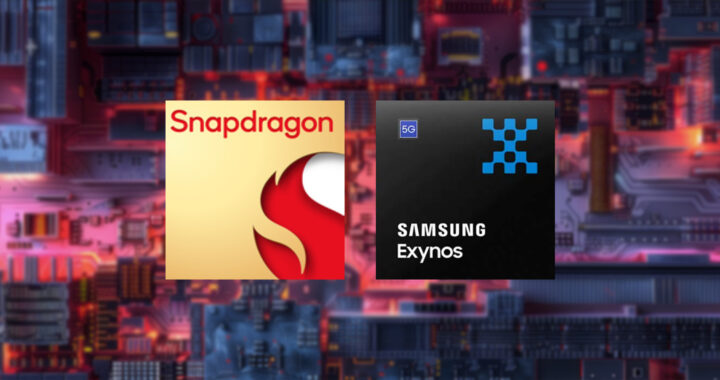Android smartphones and tablets under the Samsung Galaxy line come in either Samsung Exynos or Qualcomm Snapdragon. Samsung Electronics first started using its first Exynos chip in its first Android smartphone called the Samsung Galaxy S. However, beginning with the Samsung Galaxy S2, the company started implementing its dual-sourcing strategy as part of its overall chip. It uses Snapdragon chips in regions like China, South Korea, and the United States, and Exynos chips in Europe and other parts of the world.
Mobile Chip Clash: Snapdragon vs Exynos Comparison
There is a sizeable number of consumers that prefer a Samsung device powered by a Snapdragon chip over devices running on Samsung Exynos. This is understandable. Qualcomm has a strong track record of designing powerful mobile systems-on-a-chip. Most manufacturers catering to less price-sensitive consumers also prefer Snapdragon chips over MediaTek Helio and Dimensity chips because of this strong brand reputation. However, in more recent years, Samsung Electronics has made significant improvements to the design of its mobile SoCs. The following is a comparison between Qualcomm Snapdragon and Samsung Exynos chips:
1. Instruction Set Architecture
Both brands of mobile SoCs are based on the ARM architecture. ARM is a reduced instruction set computing or RISC architecture. This is the same architecture used in chips from MediaTek and the range of chips from Apple like the A series used in iPhone and some models of the iPad and the Apple M series beginning with the Apple M1 used in Mac computers and higher-end models of the iPad line of tablet computers.
The two brands use the same big.LITTLE heterogeneous computing architecture of ARM Cortex CPU cores in which the CPU cores are categorized between performance cores and power-efficient cores. However, to differentiate itself, Qualcomm uses custom ARM Cortex CPU cores that are branded as Kryo. Samsung once used custom ARM Cortex CPU cores called Mongoose cores but shifted back to using standard ARM Cortex cores.
2. General-Purpose Performance
Snapdragon is often preferred over Exynos because of its performance. It often outperforms Exynos. For example, the Snapdragon 888 outperforms Exynos 2100 in terms of single-core and multi-core tests and power efficiency. Both chips were first introduced in 2021 and were used in Samsung Galaxy S21. The devices in the international market came with Exynos chips and those in North America and East Asia came with Snapdragon.
It is true that newer generations of Snapdragon chips still outperform newer generations of Exynos chips. However, when it comes to general-purpose performance, the gap is not wide. Samsung has also made several improvements in recent years. For example, considering Snapdragon 8 Gen 3 and Exynos 2400, which are used in either version of the Samsung Galaxy S24, there is about between 5 and 7 percent difference between the two.
3. Integrated Graphics Processing
Another difference between Snapdragon and Exynos rests on the architecture and performance of their integrated GPUs. Qualcomm uses its in-house designed Adreno GPU for all Snapdragon. This is one of the defining features of these chips. Older Exynos chips use the stock ARM Mali GPUs but newer ones beginning with Exynos 2200 now feature a Samsung Xclipse GPU set based on the RDNA microarchitecture of AMD.
Snapdragon still outclasses Exynos. The 8 Gen 3 chip scored 896405 in AnTuTu 10 graphics while the 2400 scored 722765 in the same benchmark test. This comes from the fact that the proprietary Adreno GPU is highly optimized for mobile graphics workloads. Qualcomm has also optimized its GPU through partnerships with software and game developers. The Samsung Xclipse GPU is still new but its RDNA microarchitecture is promising.
4. Artificial Intelligence Acceleration
Both brands have also implemented artificial intelligence acceleration to allow native or on-device handling of AI inferences and respond to the growing demand for generative AI applications in mobile devices. Snapdragon specifically uses its Hexagon digital signal processor as its main AI accelerator and has also introduced the Qualcomm AI Engine that combines hardware and software features for on-device processing of AI workloads.
Exynos has featured a dedicated neural processing unit or NPU since the Exynos 990. The recent models have integrated NPU with the RDNA-based Xclipse GPU and a digital signal processor to bring in better AI graphics rendering and computation workload and support various specific AI workloads and applications like running generative AI features, computational photography and videography, and improved smart management, among others.
5. Power Efficiency and Heat Management
Another key point of comparison between Snapdragon and Exynos is power efficiency and thermal management. The former is generally more power-efficient. Qualcomm has achieved this through its custom Kryo CPU and Adreno GPU. The company designs Snapdragon chips in consideration of balancing performance with power consumption. This also translates to longer battery life and more effective thermal management.
Samsung used to have issues with power efficiency and excessive heating. These were pronounced in previous generations like the Exynos 2000 and when devices are running resource-intensive apps or workloads like extended mobile gaming. The transition to the standard ARM Cortex CPU cores and custom Xclipse GPU based on the RDNA of AMD has helped in reducing these issues. It is still not as power efficient as Snapdragon.
